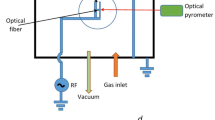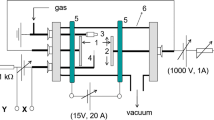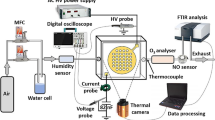Abstract
A robust, commercial micro-hollow plasma source was used to generate atmospheric-pressure plasma, of surface area 18 × 18 mm, in ambient air, nitrogen and argon. An electrode system consisting of 105 micro-hollow surface dielectric barrier discharges was powered by sinusoidal high-voltage at a frequency of 26.7 kHz. The influence of the plasmas on the polycarbonate surface was investigated by means of surface energy measurements and X-ray photoelectron spectroscopy. It emerged that short plasma exposures led to significant increases in surface energy. It is suggested that this may arise out of incorporation of polar groups on the polycarbonate surface. A thermal camera was used to monitor the plasma source surface temperatures for the gases at flow rates ranging from 0 to 5 L/min. It was found that the temperature of the micro-hollow ceramic when operated upon in ambient air decreased significantly from 147 °C at 0 L/min to 49 °C at 5 L/min. In order to investigate further the thermal properties of the plasma, optical emission spectroscopy was employed to monitor the vibrational and rotational temperatures of the plasma generated in ambient air. CCD camera spectroscopic measurements estimated plasma thickness and temperature distribution at high spatial resolution.








Similar content being viewed by others
References
Schoenbach KH, Becker K (2016) 20 years of microplasma research: a status report. Eur Phys J D 70:29. doi:10.1140/epjd/e2015-60618-1
Foest R, Schmidt M, Becker K (2006) Microplasmas, an emerging field of low-temperature plasma science and technology. Int J Mass Spectrom 248:87–102. doi:10.1016/j.ijms.2005.11.010
Becker K, Koutsospyros A, Yin S-M et al (2005) Environmental and biological applications of microplasmas. Plasma Phys Controll Fusion 47:B513–B523. doi:10.1088/0741-3335/47/12B/S37
Iza F, Kim GJ, Lee SM et al (2008) Microplasmas: sources, particle kinetics, and biomedical applications. Plasma Process Polym 5:322–344
Meyer C, Demecz D, Gurevich EL et al (2012) Development of a novel dielectric barrier microhollow cathode discharge for gaseous atomic emission spectroscopy. J Anal At Spectrom 27:677–681. doi:10.1039/c2ja10225k
Tachibana K, Nakamura T, Motomura H et al (2016) Monolithic structure of integrated coaxial microhollow dielectric barrier discharges: characterization for environmental and biomedical applications. Jpn J Appl Phys 55:07LB01. doi:10.7567/JJAP.55.07LB01
Jiang P-C, Wang W-C, Zhang S et al (2014) An uniform DBD plasma excited by bipolar nanosecond pulse using wire-cylinder electrode configuration in atmospheric air. Spectrochim Acta Part A Mol Biomol Spectrosc 122:107–112. doi:10.1016/j.saa.2013.10.004
Dutton J (1975) A survey of electron swarm data. J Phys Chem Ref Data 4:577. doi:10.1063/1.555525
Kozlov KV, Brandenburg R, Wagner H-E et al (2005) Investigation of the filamentary and diffuse mode of barrier discharges in N2/O2 mixtures at atmospheric pressure by cross-correlation spectroscopy. J Phys D Appl Phys 38:518–529. doi:10.1088/0022-3727/38/4/003
Brandenburg R, Maiorov VA, Golubovskii YB et al (2005) Diffuse barrier discharges in nitrogen with small admixtures of oxygen: discharge mechanism and transition to the filamentary regime. J Phys D Appl Phys 38:2187–2197. doi:10.1088/0022-3727/38/13/017
Klages C-P, Grishin A (2008) Plasma amination of low-density polyethylene by DBD afterglows at atmospheric pressure. Plasma Process Polym 5:368–376. doi:10.1002/ppap.200700142
Chiang M-H, Liao K-C, Lin I-M et al (2010) Effects of oxygen addition and treating distance on surface cleaning of ITO glass by a non-equilibrium nitrogen atmospheric-pressure plasma jet. Plasma Chem Plasma Process 30:553–563. doi:10.1007/s11090-010-9237-4
Homola T, Wu LYL, Černák M (2014) Atmospheric plasma surface activation of poly(ethylene terephthalate) film for roll-to-roll application of transparent conductive coating. J Adhes 90:296–309. doi:10.1080/00218464.2013.794110
Keil M, Rastomjee CS, Rajagopal A et al (1998) Argon plasma-induced modifications at the surface of polycarbonate thin films. Appl Surf Sci 125:273–286. doi:10.1016/S0169-4332(97)00501-1
Muir BW, Mc Arthur SL, Thissen H et al (2006) Effects of oxygen plasma treatment on the surface of bisphenol A polycarbonate: a study using SIMS, principal component analysis, ellipsometry, XPS and AFM nanoindentation. Surf Interface Anal 38:1186–1197. doi:10.1002/sia.2363
Seidel C, Kopf H, Gotsmann B et al (1999) Ar plasma treated and Al metallised polycarbonate: a XPS, mass spectroscopy and SFM study. Appl Surf Sci 150:19–33. doi:10.1016/S0169-4332(99)00012-4
Fridman A (2008) Plasma chemistry. Cambridge University Press, Cambridge
Šimek M, Dilecce G, DeBenedictis S (1995) On the use of the numerical simulation of the first positive system of N−2: 1. Emission and LIF analysis. Plasma Chem Plasma Process 15(3):427–449
Šimek M (2014) Optical diagnostics of streamer discharges in atmospheric gases. J Phys D Appl Phys 47:463001. doi:10.1088/0022-3727/47/46/463001
Hoder T, Šíra M, Kozlov KV, Wagner H-E (2009) 3D Imaging of the single microdischarge development in coplanar barrier discharges in synthetic air at atmospheric pressure. Contrib Plasma Phys 49:381–387. doi:10.1002/ctpp.200910035
von Woedtke T, Reuter S, Masur K, Weltmann K-D (2013) Plasmas for medicine. Phys Rep 530:291–320. doi:10.1016/j.physrep.2013.05.005
Acknowledgements
The authors would like to acknowledge financial support from project LO1411 (NPU I), funded by Ministry of Education, Youth and Sports of the Czech Republic. Tony Long (Svinošice) helped work up the English.
Author information
Authors and Affiliations
Corresponding author
Electronic supplementary material
Below is the link to the electronic supplementary material.
Rights and permissions
About this article
Cite this article
Homola, T., Krumpolec, R., Zemánek, M. et al. An Array of Micro-hollow Surface Dielectric Barrier Discharges for Large-Area Atmospheric-Pressure Surface Treatments. Plasma Chem Plasma Process 37, 1149–1163 (2017). https://doi.org/10.1007/s11090-017-9792-z
Received:
Accepted:
Published:
Issue Date:
DOI: https://doi.org/10.1007/s11090-017-9792-z




